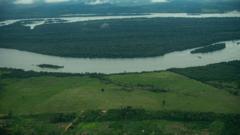The Australian Institute of Marine Science has documented a worrying trend with the Great Barrier Reef experiencing the largest annual coral decline since monitoring began nearly four decades ago, raising alarm over the impact of climate change and powerful natural forces on this vital ecosystem.
Unprecedented Coral Decline Hits Great Barrier Reef Amid Rising Climate Threats

Unprecedented Coral Decline Hits Great Barrier Reef Amid Rising Climate Threats
New reports reveal the Great Barrier Reef is experiencing its most significant annual coral cover decline on record, largely attributed to climate change and other environmental stressors.
Parts of the Great Barrier Reef are grappling with the most severe annual decline in coral coverage recorded to date, marking a critical moment for one of the planet's most iconic ecosystems. According to the latest findings from the Australian Institute of Marine Science (AIMS), both the northern and southern branches of the reef have suffered widespread coral bleaching during this period.
The report highlights that while tropical cyclones and outbreaks of crown-of-thorns starfish have contributed to the reef's deterioration, the main culprit is the intense heat stress exacerbated by climate change. AIMS cautions that the reef may be approaching a tipping point, where it can no longer recuperate rapidly enough between devastating events, leading to an uncertain and perilous future.
AIMS conducted surveys on the health of 124 coral reefs between August 2024 and May 2025, continuing their assessment that has spanned nearly four decades since 1986. Spanning over 2,300 kilometers (approximately 1,429 miles), the Great Barrier Reef is revered as the world's largest living structure and supports a rich diversity of marine life. Unfortunately, repeated bleaching events have left vast sections of previously vibrant coral bleached and lifeless.
This year saw a worrying first; Australia's second-largest reef, Ningaloo, also suffered from concurrent bleaching alongside the Great Barrier Reef. Coral, often termed the ocean's architect, plays a crucial role by forming expansive structures that provide habitat to approximately 25% of all marine species.
Bleaching occurs when corals become stressed, causing them to turn white due to excessive water temperatures. Historically, while corals can recover from brief heat stress, they require time to recuperate—usually several years. Recent reports indicate that coral may not survive if it endures temperatures just 1°C higher than their thermal limit for over two months.
The Great Barrier Reef has undergone an alarming rate of heating, which triggered extensive coral bleaching in both 2024 and early 2025, marking the sixth significant event since 2016. AIMS noted that unprecedented levels of heat stress have resulted in the most severe and widespread bleaching events recorded.
The ability of the reef to recover hangs in the balance, depending on successful coral reproduction and minimized environmental disturbances. Notably, the Acropora species has been the hardest hit—these fast-growing corals are most vulnerable to heat stress and favored by crown-of-thorns starfish.
Despite the grim outlook, AIMS research lead Dr. Mike Emslie remains hopeful, recognizing the intrinsic potential of the reef to recover if given the chance. Australia's government has had some success with its crown-of-thorns starfish culling initiative, which has eradicated over 50,000 starfish to date, contributing positively to reef recovery efforts.
However, WWF representative Richard Leck warns that the current state of stress for the reef is alarming, indicating that some coral reefs globally are already past the point of recovery. Without urgent and extensive climate action, Leck cautions that the Great Barrier Reef could meet a similar fate.
Despite its heritage status, which has been upheld for over 40 years, UNESCO continues to express concern for the Great Barrier Reef, labeling it as "in danger" due to ongoing threats from rising sea temperatures and pollution.




















